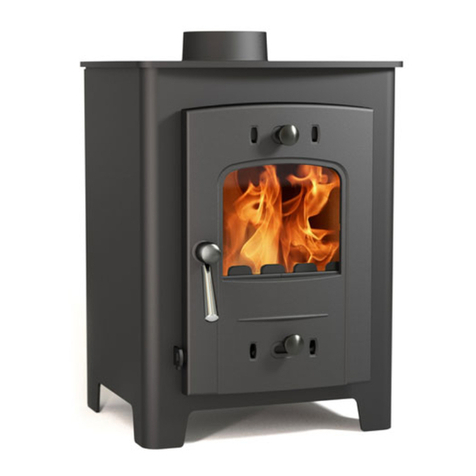SAFETY
A fireguard conforming to BS 8423:2010 should be
used in the presence of children, the old or infirm.
Please note, this appliance should be used with
the fire door closed at all times except when
fuelling, de-ashing or initial lighting.
Do not use aerosol sprays or any other
flammable materials near the appliance
under fire.
Fire cement is caustic, hand and eye
protection should always be worn,
prolonged contact with the skin should be
avoided.
Arada Ltd will not be responsible for any
consequential or incidental loss or
injury however caused.
Before continuing any further with the
installation of this appliance please read the
following guide to manual handling.
Always obtain assistance when lifting the
appliance.
When lifting always keep your back straight,
bend your legs not your back.
Avoid twisting at the waist. It is better to
reposition your feet.
Avoid upper body/top heavy lifting. Do not lean
forwards or sideways when handling the fire.
Always grip with the palms of your hands.
Do not use your fingertips for support, use
gloves for a better grip.
Always keep the stove close to the body as this
will minimise the cantilever action.
CO ALARM
Building regulations require that whenever a new
or replacement fixed solid fuel or wood / biomass
appliance is installed in a dwelling a Carbon
Monoxide Alarm must be fitted in the same room
as the appliance. Further guidance on the
installation of the CO Alarm is available in
BS EN 50292:2002 and from the alarm
manufacturers instruction.
Provision of an alarm must not be considered
a substitute for either installing the appliance
correctly or ensuring regular servicing and
maintenance of the appliance and chimney
system.
THE PRINCILE OF THE STOVE
Your HSB Boiler Stove is built to the highest
standard of craftsmanship using the best materials
and most modern equipment available. It is a highly
efficient and sophisticated piece of machinery and
when properly installed and operated it should
provide a lifetime of heating satisfaction.
Safety is the most important consideration when
installing your fire. If not properly installed and
operated a house fire may result. Installation must
comply with the Building regulations and conform to
all safety standards.
Arada produce a variety of appliances ranging from
the traditional to the modern in style and appearance,
all bristling with ‘High Tech’ features.
The fire door is fitted with a special high temperature
ceramic glass panel through which the fire can be
viewed.
An internal throat plate produces turbulence to
encourage secondary combustion and direct the flue
gas around the whole upper firebox before allowing it
to escape up the chimney.
Arada stoves are also fitted with an ‘air wash’ so
called because it provides a curtain of high speed
preheated air behind the glass to help keep it clean
and provide secondary air /over draught.
The air inlets on the stove give a wide range of
primary / secondary air, under draught / over draught
combinations. The optimum setting will only be
established by experience in firing the appliance,
and will depend on the type of fuel, the position of
the appliance in the house, conditions of chimney
etc..
Asbestos
This stove contains no asbestos.
If there is a possibility of disturbing any asbestos in
the course of installation then please seek specialist
guidance and use appropriate protective equipment.
Electrical Connections
The installation of any electrical services during the
installation of this boiler and associated heating
system must be carried out by a registered
competent electrician and in accordance with the
requirements of the latest issue of BS 7671.
The design, installation and commissioning of any
water based heating system should be in accordance
with the following standards:-
BSEN12828:2003; BSEN12831:2003
BSEN14336:2004
HSB Boiler Stove
INTRODUCTION
5





























